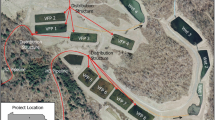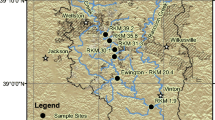Abstract
The attenuation of residual industrial loads of chloride (Cl-) and total ammonia (T-NH3) from Solvay waste bedsto Ninemile Creek, New York, and downstream polluted Onondaga Lake, is characterized and quantified based on fourteen years ofmonitoring following closure of a soda ash manufacturing facility. Concentrations of these constituents were monitored atleast bi-weekly at two sites on Ninemile Creek that bound the waste bed inputs, and at the mouths of the two other major tributaries to the lake, to quantify inputs from the industrial deposits and to place these residual loads in the perspective of contributions to total lake loading. Variations in the concentrations of these constituents in Ninemile Creek downstreamof the industrial inputs within individual years are well represented by a dilution model; i.e., linearity of concentrationversus inverse stream flow. A relatively uniform ratio of T-NH3 to Cl- has been maintained in the residual loading, about 0.42 g T-NH3 per kg Cl-. Substantial decreases (∼40%) in loading of these constituents fromthe waste beds to Ninemile Creek over the post-closure period are documented through shifts in the dilution model. As a result,the contribution of this source to the total lake loading has decreased from ∼45% to <30%. The estimated total residual Cl- load received from the waste beds since closure of the industry (∼1 million metric tons) corresponds to ∼1.6 yr of the full operating load of the industry before closure. The time required to reach a Cl- concentration goal for Ninemile Creek is considered, based onprojections of the post-closure trend.
Similar content being viewed by others
References
Alavian, V., Jirka, G. H., Denton, R. A., Johnson, M. C. and Stefan, H. G.: 1992, ‘Density currents entering lakes and reservoirs’, J. Hydraulic Engrg. Div. ASCE 118, 1464-1489.
APHA (American Public Health Association): 1985, Standard Methods for the Examination of Water and Wastewater, 16th ed., American Public Health Association, Washington, DC.
Auer, M. T., Effler, S. W., Storey, M. L., Connors, S. D., Sze, P., Siegfried, C. A., Auer, N. A., Madsen, J. D., Smart, R. M., Eichler, L. W., Boylen, C. W., Sutherland, J. W., Bloomfield, J. A., Wagner, B. A., Danehey, R., Ringler, N. A., Gandino, C., Hirethota, P., Tango, P., Arrigo, M. A., Morgan, C., Millard, C., Murphy, M., Sloan, R. J., Niehaus, S. L. and Whitehead, K. A.: 1996, ‘Biology’, in S. W. Effler (ed.), Limnological and Engineering Analysis of a Polluted Urban Lake. Prelude to Environmental Management of Onondaga Lake, New York, Springer-Verlag, New York, pp. 384-534.
Azadpour-Keeley, A., Keeley, J. W., Russell, H. H. and Sewell, G. W.: 2001a, ‘Monitored natural attenuation of contaminants in the subsurface: Processes’, Ground Water Monit. Rem. 21(2), 97-107.
Azadpour-Keeley, A., Keeley, J. W., Russell, H. H. and Sewell, G. W.: 2001b, ‘Monitored natural attenuation of contaminants in the subsurface: Applications’, Ground Water Monit. Rem. 21(3), 136-143.
Birge, W. J., Black, J. A., Waterman, A. G., Short, T. M., Taylor, S. B., Bruser, D. M. and Wallingford, E. D.: 1985, Recommendations on Numerical Values for Regulating Iron and Chloride Concentrations for the Purpose of Protecting Warmwater Species of Aquatic Life in the Commonwealth of Kentucky, School of Biol. Sciences, University of Kentucky, Lexington, KY.
Blasland and Bouck Engineers: 1989, Hydrogeologic Assessment of the Allied Waste Beds in the Syracuse Area, Vol. 1, Submitted to Allied-Signal, Inc. Solvay, NY.
Doerr, S. M., Effler, S. W., Whitehead, K. A., Auer, M. T., P erkins, M. G. and Heidtke, T. M.: 1994, ‘Chloride model for polluted Onondaga Lake’, Wat. Res. 28, 849-861.
Effler, S. W.: 1987, ‘The impact of a chlor-alkali plant on Onondaga Lake and adjoining systems’, Water, Air, and Soil Pollut. 33, 85-115.
Effler, S. W.: 1996, Limnological and Engineering Analysis of a Polluted Urban Lake. Prelude to Environmental Management of Onondaga Lake, New York, Springer-Verlag, New York, NY.
Effler, S. W., Brooks, C. M., Addess, J. M., Doerr, S. M., Storey, M. L. and Wagner, B. A.: 1991, ‘Pollutant loadings from solvay waste beds to lower Ninemile Creek, NY’, Water, Air, and Soil Pollut. 55, 427-444.
Effler, S. W., Brooks, C. M., Whitehead, K. A., Wagner, B., Doerr, S. M., Perkins, M. G., Siegfried, C. A., Walrath, L. and Canale, R. P.: 1996b, ‘Impact of zebra mussel invasion on river water quality’, Wat. Environ. Res. 68, 205-214.
Effler, S. W., Doerr, S. M. and Owens, E. M.: 1997, ‘Effect of reduced salinity input on river stratification and dissolved oxygen’, Water, Air, and Soil Pollut. 95, 45-58.
Effler, S. W., Matthews (Brooks), C. M. and Driscoll, C. T.: 2001a, ‘Changes in deposition of phytoplankton constituents in a Ca2+ polluted lake’, Environ. Sci. Technol. 35, 3082-3088.
Effler, S. W., O'Donnell, S. M., Matthews, D. A., Matthews, C. M., O'Donnell, D. M., Auer, M. T. and Owens, E. M.: 2001b, ‘Limnological and loading information and a phosphorus total maximum daily load (TMDL) analysis for Onondaga Lake’, Lake Reserv. Manage. 18, 87-108.
Effler, S. W., Perkins, M. G., Whitehead, K. A. and Romanowicz, E. A.: 1996a, ‘Ionic inputs to Onondaga Lake: Origins, character, and changes’, Lake Reserv. Manage. 12, 15-23.
Effler, S. W. and Whitehead, K. A.: 1996, ‘Tributaries and Discharges’, in S. W. Effler (ed.), Limnological and Engineering Analysis of a Polluted Urban Lake. Prelude to Environmental Management of Onondaga Lake, New York, Springer-Verlag, New York, NY, pp. 97-199.
Gehrels, J. and Puumala, M.: 2000, ‘A method for predicting chloride concentrations in leachate at natural attenuation landfills in the precambrian shield regions of Ontario, Canada’, Ground Water Monit. Rem. 20, 169-176.
Gelda, R. K., Effler, S.W. and O'Donnell, S. M.: 2001, ‘Probabilistic model of ammonia and toxicity status for urban lake’, J. Water Res. Plan. Manage. 127, 337-347.
Islam, I., Singhal, N. and O'Sullivan, M.: 2001, ‘Modeling biogeochemical processes in leachatecontaminated soils: A review’, Transport in Porous Media 43, 407-440.
Johnson, A. H.: 1979, ‘Estimating solute transport in streams from grab samples’, Wat. Resour. Res. 15, 1224-1228.
Manczak, H. and Florczyk, L.: 1971, ‘Interpretation of results from the studies of pollution of surface flowing waters’, Wat. Res. 5, 575-584.
Matthews, D. A., Effler, S. W. and Matthews (Brooks), C. M.: 2000, ‘Ammonia and toxicity criteria in polluted Onondaga Lake, New York’, Wat. Environ. Res. 72, 731-741.
Matthews, D. A., Effler, S. W., Matthews (Brooks), C. M., Siegfried, C. A. and Spada, M. E.: 2001, ‘Responses of Onondaga Lake, New York, to early stages of rehabilitation: Unanticipated ecosystem feedbacks’, Wat. Environ. Res. 73, 691-703.
McAllister, P. M. and Chiang, C. Y.: 1994, ‘A practical approach to evaluating natural attenuation of contaminants in ground water’, Ground Water Monit. Rem. 14, 161-173.
Onondaga County: 1988, Onondaga Lake Monitoring Program, Annual Report 1987, Department of Drainage and Sanitation, Onondaga County, Syracuse, NY.
Onondaga County: 1989, Onondaga Lake Monitoring Program, Annual Report 1988, Department of Drainage and Sanitation, Onondaga County, Syracuse, NY.
Onondaga County: 2000, Onondaga Lake Monitoring Program, Annual Report 1999, Onondaga County Department of Drainage and Sanitation, Syracuse, NY.
Owens, E. M. and Effler, S. W.: 1996, ‘Hydrodynamics and Transport’, in S. W. Effler (ed.), Limnological and Engineering Analysis of a Polluted Urban Lake. Prelude to Environmental Management of Onondaga Lake, New York, Springer-Verlag, New York, NY, pp. 200-262.
Perkins, M. G. and Romanowicz, E. A.: 1996, ‘Hydrogeologic Settling’, in S. W. Effler (ed.), Limnological and Engineering Analysis of a Polluted Urban Lake. Prelude to Environmental Management of Onondaga Lake, New York, Springer-Verlag, New York, NY, pp. 32-96.
Rittmaster, R. L. and Mueller, D. K.: 1986, ‘Identification of solute loading sources to a surface stream’, Wat. Resour. Bull. 22, 81.
Rowell, C.: 1996, ‘Paleolimnology of Onondaga Lake: The history of anthropogenic impacts on lake water quality’, Lake Reserv. Manage. 12, 35-45.
Siewert, H. F., Miller, C. J. and Torke, B. G.: 1989, ‘Water quality and macroinvertebrate populations before and after a hazardous waste cleanup’, Wat. Resour. Bull. 25, 685.
Swift, M. C.: 1985, ‘Effects of coal pile runoff on stream quality and macroinvertebrate communities’, Wat. Resour. Bull. 21, 449.
Tango, P. J. and Ringler, N. H.: 1996, ‘The role of pollution and external refugia in structuring the Onondaga Lake fish community’, Lake Reserv. Manage. 12, 81-90.
Thomann, R. V. and Mueller, J. A.: 1987, Principles of Surface Water Quality Modeling and Control, Harper & Row Publishers, NY.
U.S. EPA (United States Environmental Protection Agency): 1974, ‘Environmental Impact Statement on Wastewater Treatment Facilities Construction Grants for the Onondaga Lake Drainage Basin, Region II’, New York, NY.
U.S. EPA (United States Environmental Protection Agency): 1983, ‘Methods for Chemical Analysis of Water and Wastes’, EPA/600/4-79/020, Environ. Monit. Support Lab., Cincinnati, Ohio.
U.S. EPA (United States Environmental Protection Agency): 1985, ‘Ambient Water Quality Criteria for Ammonia - 1984’, EPA-440/5-85-001, Office of Water Regulations and Standards Criteria and Standards Division, Washington, DC.
U.S. EPA (United States Environmental Protection Agency): 1988, ‘Ambient Water Quality Criteria for Chloride - 1988’, EPA-440/5-88-001, Office ofWater Regulations and Standards Criteria and Standards Division, Washington, DC.
U.S. EPA (United States Environmental Protection Agency): 1991a, ‘Guidance for Water Quality-Based Decisions: The TMDL Process’, EPA 440-4-91-001, Office of Water, Washington, DC.
U.S. EPA (United States Environmental Protection Agency): 1991b, ‘Technical Support Document for Water Quality-Based Toxics Control’, EPA 505-2-90-001, Office of Water, Washington, DC.
U.S. EPA (United States Environmental Protection Agency): 1998, ‘1998 Update of Ambient Water Quality Criteria for Ammonia’, EPA 822-R-98-008, Office of Water Regulations and Standards Criteria and Standards Division, Washington, DC.
Webster, D. A.: 1982, ‘Early history of the Atlantic salmon in New York’, New York Fish Game Journal 29, 26-44.
Wetzel, R. G.: 2001, Limnology: Lake and Reservoir Ecosystems, Academic Press, New York.
Womble, R. N., Driscoll, C. T. and Effler, S. W.: 1996, ‘Calcium carbonate deposition in Ca2+ polluted Onondaga Lake, New York, U.S.A.’, Wat. Res. 30, 2139-2147.
Young, T. C., DePinto, J. V. and Heidtke, T. M.: 1988, ‘Factors affecting the efficiency of some estimators of fluvial total phosphorus loads’, Wat. Resour. Res. 24, 1535.
Author information
Authors and Affiliations
Rights and permissions
About this article
Cite this article
Matthews, D.A., Effler, S.W. Decreases in Pollutant Loading from Residual Soda Ash Production Waste. Water, Air, & Soil Pollution 146, 55–73 (2003). https://doi.org/10.1023/A:1023912626260
Issue Date:
DOI: https://doi.org/10.1023/A:1023912626260




